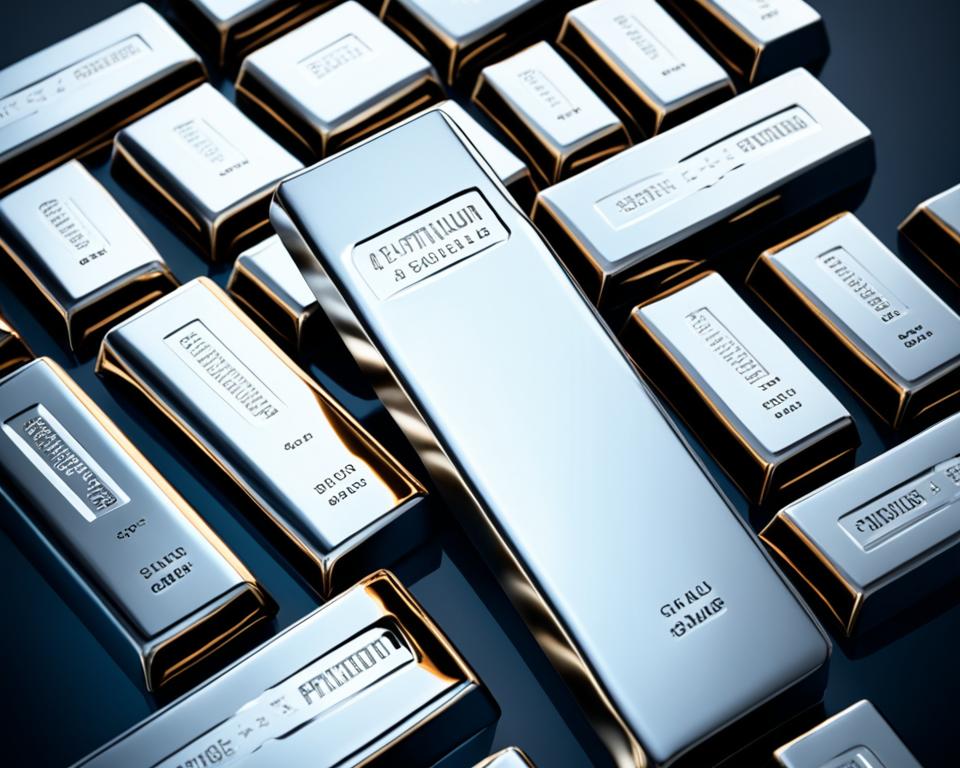If you’re looking for a unique investment opportunity, platinum may be worth considering. As a rare and valuable precious metal, platinum offers potential benefits for investors looking to diversify their portfolios. With its limited supply and various industrial applications, investing in platinum can provide opportunities for long-term growth and wealth preservation.
But is platinum a good investment? In this article, we will explore the different types of platinum investments, discuss the pros and cons of investing in platinum, and provide tips and strategies for investing in this precious metal. Whether you’re a seasoned investor or just starting out, this guide will help you navigate the platinum investment market and make informed decisions about your investment options.
Key Takeaways:
- Investing in platinum can provide diversification and a hedge against inflation.
- There are various ways to invest in platinum, including physical platinum, platinum ETFs, and platinum stocks.
- Pros of investing in platinum include its industrial demand and potential for long-term growth.
- Factors to consider when investing in platinum include market conditions, risk management, and costs.
- Consulting a financial advisor and staying informed about market trends are important for successful platinum investments.
Different Types of Platinum Investments
When it comes to investing in platinum, there are various options available to suit different investment goals and preferences. Let’s explore the different types of platinum investments:
1. Physical Platinum
Physical platinum refers to owning platinum in its physical form, such as platinum bullion, coins, or bars. Investing in physical platinum allows you to have direct ownership of the metal and gives you the flexibility to store and hold it as you see fit. This tangible form of platinum investment is favored by some investors who appreciate the tangibility and security it provides.
2. Platinum ETFs
Platinum exchange-traded funds (ETFs) are investment vehicles that offer exposure to platinum prices without the need to physically own the metal. These ETFs hold physical platinum and issue shares that can be bought and sold on the stock exchange. Investing in platinum ETFs provides a convenient way to gain exposure to platinum’s price movements and takes away the hassle of physical storage and security.
3. Platinum Stocks
Investing in platinum stocks involves buying shares of companies that are involved in platinum mining or use platinum as a primary component in their businesses. This type of investment allows you to participate in the potential growth of platinum prices and the success of platinum-related companies. It is important to conduct thorough research on individual companies before making investment decisions.
Each type of platinum investment has its own advantages and considerations. The table below summarizes the key characteristics of physical platinum, platinum ETFs, and platinum stocks:
| Type of Investment | Advantages | Considerations |
|---|---|---|
| Physical Platinum | Direct ownership Tangibility and security |
Storage and security Higher initial investment Potential for liquidity challenges when selling |
| Platinum ETFs | Convenient exposure to platinum prices Liquidity |
No physical ownership Expense ratio and management fees Potential tracking error |
| Platinum Stocks | Potential growth opportunities Diversification through company investments |
Risk associated with individual companies Market volatility |
Investors should carefully consider their investment objectives, risk tolerance, and time horizon before choosing the most suitable type of platinum investment.
Pros and Cons of Investing in Platinum
Investing in platinum offers both advantages and disadvantages. Understanding the pros and cons is crucial in making informed investment decisions. Let’s take a closer look at the benefits and drawbacks of investing in platinum:
Pros of Investing in Platinum
1. Diversification: Platinum provides an opportunity to diversify your investment portfolio, reducing risk by adding a different asset class.
“Diversification is a key principle of portfolio management. By investing in platinum, you can spread your risk across multiple assets and potentially enhance your overall returns.”
2. Industrial Demand: Platinum has significant industrial demand, particularly in the automotive, jewelry, and electronics sectors. This creates a stable market for the precious metal.
“Platinum’s industrial applications contribute to its value, making it an attractive investment option. As industries continue to rely on platinum for various purposes, its demand remains steady.”
3. Hedge Against Inflation: Platinum is often considered a hedge against inflation. Its value may increase during inflationary periods, preserving your wealth.
“Platinum’s scarcity and intrinsic value make it a potential hedge against inflation. By investing in platinum, you can protect the purchasing power of your wealth when inflation erodes the value of fiat currencies.”
4. Wealth Preservation: Platinum has historically served as a store of value, aiding in wealth preservation and providing long-term appreciation potential.
“Platinum’s status as a precious metal makes it a reliable form of wealth preservation. Over time, platinum has demonstrated the ability to retain its value and even appreciate, making it an attractive option for long-term investors.”
Cons of Investing in Platinum
1. Higher Costs: Platinum is more expensive than other precious metals like gold or silver. Investing in platinum requires a higher upfront investment and may involve additional costs such as storage and insurance.
“Investing in platinum requires a larger initial capital outlay compared to other precious metals. Additionally, the costs associated with storing and insuring physical platinum holdings can be higher.”
2. Illiquid Market: The physical platinum market can be less liquid compared to other investment options. Buying and selling physical platinum may involve longer wait times and higher transaction costs.
“The physical platinum market can be illiquid, which means it may take longer to find a buyer or seller for your platinum holdings. This can potentially impact your ability to quickly liquidate your investment.”
Take a look at the table below for a quick comparison of the pros and cons of investing in platinum:

Factors to Consider When Investing in Platinum
Before investing in platinum, you need to carefully consider several factors that can significantly impact your investment decisions. By understanding these key factors, you can make informed choices that align with your financial goals and risk tolerance.
Market Conditions
The market conditions play a crucial role in determining platinum prices. Factors such as geopolitical risks and economic indicators can influence market sentiment and the demand for platinum. It is important to stay updated with the latest market news and trends to anticipate potential price fluctuations and make strategic investment decisions.
Investment Options
Platinum offers various investment options, each with its own risks and costs. Some popular investment vehicles include physical platinum, platinum ETFs, and platinum stocks. It is essential to research and understand the characteristics of each investment option to choose the one that aligns with your investment goals and risk appetite.
Risk Management
As with any investment, risk management is crucial when investing in platinum. Diversifying your portfolio across different assets can help mitigate risk and protect your investments. Additionally, conducting thorough research, setting realistic expectations, and monitoring your platinum investments closely can aid in managing potential risks effectively.
Costs and Taxes
Investors should be aware of the associated costs and taxes when investing in platinum. These costs can include purchase premiums, storage fees, and insurance expenses for physical platinum. It is advisable to calculate and factor in these costs to assess the potential returns on your investment accurately.
Platinum Market Trends
Staying informed about platinum market trends is critical for making informed investment decisions. Keeping track of supply and demand dynamics, consumer trends, and industry developments can provide valuable insights into the future performance of platinum and help you adjust your investment strategy accordingly.
Geopolitical Risks
Geopolitical risks, such as trade disputes, political instability, or regulatory changes, can significantly impact the platinum market. It is essential to assess and monitor these risks to anticipate potential disruptions in supply chains, changes in regulations, or shifts in investor sentiment that could impact platinum prices.
Supply and Demand Dynamics
The dynamics of supply and demand have a direct influence on platinum prices. Understanding the factors affecting platinum supply, such as mining production and recycling rates, as well as the demand from industries like automotive, jewelry, and electronics, can help you gauge the future price movements of platinum.
By considering these factors, you can make informed investment decisions when entering the platinum market. Engaging in thorough research, diversifying your portfolio, and seeking professional advice can contribute to a well-rounded investment strategy.
How to Invest in Platinum
When it comes to investing in platinum, it’s important to take a strategic approach. By following a few key steps, you can make informed decisions and maximize the potential of your investments.
Research Investment Options
Before diving into the platinum market, take the time to research and understand the various investment options available. This includes exploring physical platinum, platinum ETFs, and platinum stocks. Each option has its own unique characteristics, such as risk levels, liquidity, and fees. By familiarizing yourself with these options, you can make a well-informed decision.
Choose the Right Investment Vehicle
Choosing the right investment vehicle is crucial to achieving your investment goals. Consider factors such as your risk tolerance, liquidity requirements, and desired investment horizon. Physical platinum provides a tangible form of ownership, while platinum ETFs offer exposure to the metal without direct ownership. Platinum stocks allow you to invest in companies involved in platinum mining or usage. Assessing your individual needs will help you select the most suitable investment vehicle.
Open an Investment Account
To execute platinum investments, you’ll need to open an investment account with a reputable broker or dealer. Ensure that the platform you choose offers access to platinum markets and provides tools for monitoring and managing your investments. Compare fees, customer support, and the overall reputation of the platform before making a decision.
Monitor and Manage Platinum Investments
Investing in platinum requires active monitoring and management. Stay informed about market conditions, economic indicators, and platinum market trends. Regularly review your investment portfolio to assess performance and make any necessary adjustments. Remember to align your investment strategy with your financial goals and risk tolerance.
To sum up, investing in platinum can be a lucrative opportunity, but it requires thorough research, careful selection of investment vehicles, and active management. By following these steps, you can navigate the world of platinum investments with confidence and increase your chances of success.
Tips and Strategies for Investing in Platinum
When it comes to investing in platinum, there are several key tips and strategies to keep in mind. By following these guidelines, you can make informed decisions and maximize your investment potential. Here are some essential tips to consider:
Diversify Your Portfolio
One of the most important strategies is to diversify your portfolio by including various types of assets. This helps spread the risk and reduces the impact of volatility in any single investment. Including platinum as part of a diversified portfolio can provide stability and potential long-term growth.
Consult a Financial Advisor
For those new to investing in precious metals, it is highly recommended to consult a financial advisor. An experienced advisor can provide valuable guidance based on their expertise and knowledge of the platinum market. They can help you understand the risks and potential rewards of investing in platinum and tailor a strategy that aligns with your financial goals.
Keep a Long-Term Perspective
Platinum prices can be quite volatile in the short term, which is why maintaining a long-term perspective is crucial. While there may be fluctuations in the market, platinum has historically shown steady growth over time. By focusing on the long-term performance, you can avoid being swayed by short-term market movements and make more informed investment decisions.
Stay Informed About Market Trends
Staying informed about market trends, industry news, and supply and demand dynamics is essential for making informed investment decisions. Keep track of platinum prices, market reports, and news related to the platinum industry. This information will help you understand the factors influencing platinum prices and enable you to make informed decisions about buying or selling platinum.
By following these tips and strategies, you can navigate the platinum investment market with confidence and maximize the potential returns on your investment.

Platinum Investment FAQs
Are you considering investing in platinum? Here are some frequently asked questions and common concerns about platinum investments, along with answers to help you make informed decisions.
1. Is platinum a good investment?
Platinum can be a good investment option due to its limited supply and various industrial applications. It offers the potential for diversification and acts as a hedge against inflation.
2. How do I invest in platinum?
There are several ways to invest in platinum, including purchasing physical platinum in the form of bullion, coins, or bars, investing in platinum ETFs, or buying shares in platinum mining companies.
3. What are the risks associated with platinum investments?
Platinum investments come with their own set of risks, such as higher costs for storage and insurance, and the possibility of volatility in the market. It’s important to carefully consider these risks before investing.
4. How do I choose the right investment option?
Choosing the right investment option depends on your investment goals, risk tolerance, and liquidity requirements. It’s crucial to research and understand the differences between various investment vehicles.
5. Can platinum investments generate income?
No, platinum investments do not generate income in the form of dividends or interest. The potential returns come from capital appreciation when the price of platinum increases.
6. Are platinum investments liquid?
The physical platinum market can be less liquid compared to other investment options like stocks or bonds. Selling physical platinum may involve finding a buyer and may take time.
7. How should I manage my platinum investments?
Regular monitoring and management of platinum investments is important. Stay informed about market trends, industry news, and supply and demand dynamics to make well-informed decisions.
8. Is it advisable to consult a financial advisor?
Consulting a financial advisor with experience in precious metals investing can provide valuable guidance tailored to your specific financial situation and investment goals.
9. What are the tax implications of platinum investments?
It’s important to be aware of any tax obligations associated with platinum investments. Consult with a tax professional to understand the tax implications based on your jurisdiction.
10. How does platinum compare to other precious metals?
Platinum differs from other precious metals like gold and silver in terms of supply, demand, and pricing. Understanding these differences is crucial when evaluating potential investments.
11. Can investing in platinum help diversify my portfolio?
Yes, investing in platinum can help diversify your portfolio by adding exposure to an asset with a unique set of characteristics and performance drivers.
12. What are the long-term prospects for platinum investments?
The long-term prospects for platinum investments depend on various factors, including supply and demand dynamics, economic conditions, and technological advancements. It’s important to stay informed about these factors.
If you have more specific questions about investing in platinum, consider consulting with a financial professional who specializes in precious metals investments.
| Question | Answer |
|---|---|
| Is platinum a good investment? | Platinum can be a good investment option, providing diversification and acting as a hedge against inflation. |
| How do I invest in platinum? | Investing in platinum can be done through physical platinum, platinum ETFs, or shares in platinum mining companies. |
| What are the risks associated with platinum investments? | Risks include higher costs, market volatility, and the potential illiquidity of the physical platinum market. |
| Can platinum investments generate income? | No, platinum investments primarily rely on capital appreciation rather than generating income. |
| Are platinum investments liquid? | The physical platinum market can be less liquid compared to other investment options. |
| How should I manage my platinum investments? | Regular monitoring, staying informed, and adapting to market conditions are essential for managing platinum investments. |
| Is it advisable to consult a financial advisor? | Consulting a financial advisor with experience in precious metals investing can provide personalized guidance. |
| What are the tax implications of platinum investments? | Tax implications vary based on jurisdiction, so consulting a tax professional is recommended. |
| How does platinum compare to other precious metals? | Platinum has unique characteristics and performance drivers that differentiate it from other precious metals. |
| Can investing in platinum help diversify my portfolio? | Yes, investing in platinum can help diversify a portfolio. |
| What are the long-term prospects for platinum investments? | Long-term prospects depend on supply and demand dynamics, economic conditions, and technological advancements. |
Remember, investing in platinum involves risks, and it’s important to carefully evaluate the potential benefits and consider your own financial objectives before making any investment decisions.
Summary of How to Invest in Platinum
Investing in platinum can be a valuable addition to a diversified portfolio. This rare and valuable precious metal offers several potential benefits that make it an attractive investment option. Here are the key points to consider when investing in platinum:
- Diversification: Adding platinum to your investment portfolio can help diversify your holdings and reduce risk.
- Industrial demand: Platinum has significant industrial applications in sectors such as automotive, jewelry, and electronics, ensuring ongoing demand for the metal.
- Hedge against inflation: As a tangible asset, platinum can act as a hedge against inflation, helping to preserve your wealth during periods of rising prices.
- Considerations: It’s important to be aware of factors that may affect platinum investments, such as higher costs associated with storage and insurance, as well as the liquidity of the market for physical platinum.
- Research and education: Before investing in platinum, thoroughly research the available investment options and understand the risks and potential rewards associated with each.
- Choose the right investment vehicle: Determine which type of platinum investment, such as physical platinum, platinum ETFs, or platinum stocks, aligns best with your investment goals and risk tolerance.
- Open an investment account: To execute platinum investments, open an investment account with a reputable broker or dealer that offers exposure to platinum.
- Stay informed: Regularly monitor market trends, industry news, and supply and demand dynamics related to platinum to make informed investment decisions.
By following these key points and conducting thorough research, you can make informed decisions about investing in platinum and potentially benefit from its unique properties as a precious metal.
Conclusion
Investing in platinum can provide a valuable opportunity for diversification and exposure to a rare and valuable precious metal. Platinum has the potential to act as a hedge against inflation and serve as a form of wealth preservation. However, it is important to carefully consider the factors discussed in this article and seek professional advice to make informed investment decisions.
By understanding the different types of platinum investments, such as physical platinum, platinum ETFs, and platinum stocks, investors can choose the option that aligns with their investment goals and risk tolerance. It is also crucial to stay informed about market trends, supply and demand dynamics, and geopolitical risks that can impact platinum prices.
Incorporating platinum investments into your overall investment strategy requires a long-term perspective and regular monitoring of your portfolio. Diversification, consulting with a financial advisor, and staying informed are key strategies for successful platinum investing. With careful consideration, platinum can play a valuable role in achieving investment goals.
FAQ
Is platinum a good investment option?
Yes, platinum can be a good investment option as it offers diversification, industrial demand, and a hedge against inflation.
What are the different types of platinum investments?
The different types of platinum investments include physical platinum, platinum ETFs, and platinum stocks.
What is physical platinum?
Physical platinum refers to the purchase of platinum in the form of bullion, coins, or bars.
What are platinum ETFs?
Platinum ETFs are investment vehicles that provide exposure to platinum without physically owning the metal.
What are platinum stocks?
Platinum stocks are shares in companies involved in platinum mining or usage.
What are the pros of investing in platinum?
The pros of investing in platinum include diversification, industrial demand, a hedge against inflation, and wealth preservation.
What are the cons of investing in platinum?
The cons of investing in platinum include higher costs, an illiquid market, no income generation, and the need for storage and insurance.
What factors should I consider when investing in platinum?
Factors to consider include market conditions, investment options, risk management, costs and taxes, and platinum market trends.
How can I invest in platinum?
To invest in platinum, research investment options, choose the right vehicle, open an investment account, and monitor and manage your investments.
What are some tips and strategies for investing in platinum?
Tips and strategies include diversifying your portfolio, consulting a financial advisor, keeping a long-term perspective, and staying informed about market trends.
What are some common concerns about platinum investments?
Common concerns include liquidity, market volatility, and understanding the risks and costs associated with platinum investments.





